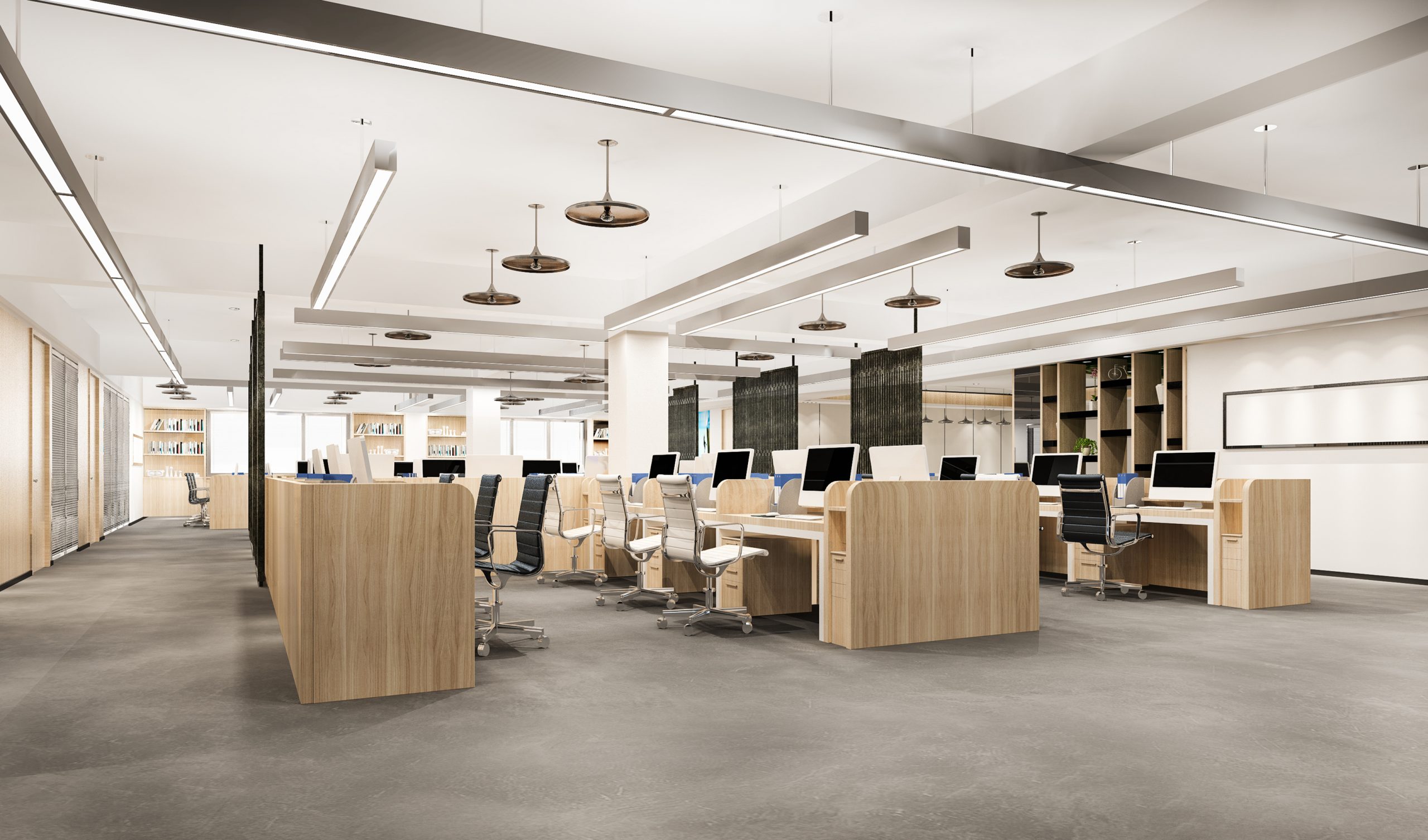-
Advice
To Rent or Own Office Space: A Decision-Making Guide
One of the biggest decisions business owners face when it comes to office space is whether to rent or own. Both options have their advantages and disadvantages, and choosing the right one for your business can be challenging. In this post, we’ll explore the pros and cons of renting vs. owning office space to help you make an informed decision.

Upfront Costs:
When it comes to upfront costs, renting is generally the less expensive option. You’ll typically need to pay a security deposit and the first month’s rent, but you won’t be responsible for any major expenses like a down payment, closing costs, or renovations. On the other hand, owning office space requires a significant investment upfront. You’ll need to come up with a down payment, pay closing costs, and potentially invest in renovations or upgrades.
Flexibility:
Renting office space provides more flexibility than owning. If your business grows quickly, you can easily move to a larger space without having to worry about selling a property. Additionally, if your business needs change, you can easily move to a new location or adjust your lease terms. Owning, on the other hand, provides less flexibility. You’ll be tied to the property for the long term, and if your business needs change, it may be more difficult to sell or rent out the space.
Control:
Owning office space provides more control over the property. You can make changes and upgrades to the space as needed, and you can build equity over time. Additionally, owning can provide tax benefits, such as deductions for mortgage interest and property taxes. When you rent, you don’t have as much control over the property. You’ll need to get permission from the landlord to make changes or upgrades, and you won’t build equity in the property over time.
Maintenance:
When you own office space, you’re responsible for all maintenance and repairs. This can be costly and time-consuming, especially if you own an older building. When you rent, the landlord is typically responsible for maintenance and repairs. This means you won’t have to worry about things like HVAC repairs, roof maintenance, or landscaping. However, you may be responsible for minor repairs like fixing a leaky faucet or replacing light bulbs.

Long-Term Costs:
When you rent office space, you’re paying for the use of the space, but you don’t have any equity in the property. When you own, you’re building equity, but you’re also responsible for ongoing expenses such as property taxes, insurance, and maintenance. You’ll need to weigh the long-term costs of each option to determine which is best for your business. If you plan to stay in one location for a long time, owning may be a better option, but if you anticipate moving in the near future, renting may make more sense.
Conclusion
Deciding whether to rent or own office space is a complex decision that requires careful consideration of your business needs, budget, and long-term goals. By weighing the pros and cons of each option, you can make an informed decision that will benefit your business in the long run. Whether you choose to rent or own, remember that your office space is an important investment in the success of your business.One of the biggest decisions business owners face when it comes to office space is whether to rent or own. Both options have their advantages and disadvantages, and choosing the right one for your business can be challenging. In this post, we’ll explore the pros and cons of renting vs. owning office space to help you make an informed decision.

Upfront Costs:
When it comes to upfront costs, renting is generally the less expensive option. You’ll typically need to pay a security deposit and the first month’s rent, but you won’t be responsible for any major expenses like a down payment, closing costs, or renovations. On the other hand, owning office space requires a significant investment upfront. You’ll need to come up with a down payment, pay closing costs, and potentially invest in renovations or upgrades.
Flexibility:
Renting office space provides more flexibility than owning. If your business grows quickly, you can easily move to a larger space without having to worry about selling a property. Additionally, if your business needs change, you can easily move to a new location or adjust your lease terms. Owning, on the other hand, provides less flexibility. You’ll be tied to the property for the long term, and if your business needs change, it may be more difficult to sell or rent out the space.
Control:
Owning office space provides more control over the property. You can make changes and upgrades to the space as needed, and you can build equity over time. Additionally, owning can provide tax benefits, such as deductions for mortgage interest and property taxes. When you rent, you don’t have as much control over the property. You’ll need to get permission from the landlord to make changes or upgrades, and you won’t build equity in the property over time.
Maintenance:
When you own office space, you’re responsible for all maintenance and repairs. This can be costly and time-consuming, especially if you own an older building. When you rent, the landlord is typically responsible for maintenance and repairs. This means you won’t have to worry about things like HVAC repairs, roof maintenance, or landscaping. However, you may be responsible for minor repairs like fixing a leaky faucet or replacing light bulbs.

Long-Term Costs:
When you rent office space, you’re paying for the use of the space, but you don’t have any equity in the property. When you own, you’re building equity, but you’re also responsible for ongoing expenses such as property taxes, insurance, and maintenance. You’ll need to weigh the long-term costs of each option to determine which is best for your business. If you plan to stay in one location for a long time, owning may be a better option, but if you anticipate moving in the near future, renting may make more sense.
Conclusion
Deciding whether to rent or own office space is a complex decision that requires careful consideration of your business needs, budget, and long-term goals. By weighing the pros and cons of each option, you can make an informed decision that will benefit your business in the long run. Whether you choose to rent or own, remember that your office space is an important investment in the success of your business.
-
Advice
Light Up Your Workspace: The Benefits of Proper Lighting for Employee Wellness and Performance
Poor lighting can cause headaches, eye strain, and fatigue, while optimal lighting can promote alertness, reduce stress, and improve mood. In this article, we will explore the connection between lighting and office productivity and provide tips on how to optimize your lighting design.
Lighting can influence our productivity by regulating our circadian rhythms, which are the natural 24-hour cycles that govern our sleep-wake cycle. Exposure to bright, blue-rich light during the day can help to regulate our circadian rhythms, making us more alert and focused during the day and improving our sleep quality at night. On the other hand, exposure to dim or warm lighting can help to relax us, and prepare us for sleep.
Furthermore, lighting can affect our mood and emotional state. Exposure to bright, blue-rich light during the day can help to boost our mood and reduce feelings of fatigue. However, exposure to bright or harsh lighting at night can disrupt our circadian rhythms, leading to difficulty in falling asleep and poor sleep quality.Tips for Optimizing Your Lighting Design
To create an optimal lighting design, here are some tips to consider:-
Use Natural Light

Natural light is the best source of light for regulating our circadian rhythms. It can improve mood, boost alertness and reduce stress. Where possible, position workstations near windows to maximize the amount of natural light in the workspace. If your office doesn’t have natural light or if you want to supplement it, consider installing skylights or light tubes to bring natural light into the space.
-
Balance Brightness and Glare

While bright lighting can help to improve productivity, too much glare can cause eyestrain and headaches. To avoid this, use shades or blinds to reduce direct sunlight, and position light fixtures so that they do not shine directly into the eyes of workers. A balanced lighting design can reduce glare and promote optimal lighting levels, improving productivity and reducing discomfort.
-
Use the Right Color Temperature
The color temperature of light can also have an impact on productivity. During the day, use bright, blue-rich light (around 5000K) to help regulate circadian rhythms and improve alertness. In the evening, switch to warmer, dimmer lighting (around 2700K) to help workers wind down and prepare for sleep. Using the right color temperature can optimize the lighting levels to improve the productivity of workers.
-
Layer Your Lighting
To create a comfortable and inviting workspace, it’s important to use a variety of lighting sources. This could include overhead lighting, task lighting for individual workstations, and ambient lighting to create a warm, welcoming atmosphere. A layered lighting design can create a comfortable and productive workspace.
-
Consider Energy Efficiency

When designing your lighting system, it’s important to consider energy efficiency. Using energy-efficient bulbs such as LED or fluorescent bulbs can reduce energy consumption and lower energy bills. Additionally, installing motion sensors or timers can ensure that lights are only on when they are needed, reducing energy waste.
-
Design Lighting to Fit the Task

Different tasks require different levels and types of lighting. For example, computer work requires brighter lighting than reading or writing. Therefore, it’s important to design your lighting system to fit the task. Use task lighting at individual workstations to ensure that workers have the proper lighting levels for their specific tasks. Conference rooms may require dimmer lighting to promote a calm and focused atmosphere, while break rooms and common areas may benefit from brighter, more inviting lighting.
-
Consult with Professionals
Designing an effective lighting system can be a complex process. Therefore, it may be beneficial to consult with lighting professionals to ensure that your lighting design meets the needs of your workspace. A professional lighting designer can help you to identify the optimal lighting levels, lighting types, and lighting sources for your office space.
Lighting is a crucial element in the design of an office space, and it can have a significant impact on productivity, mood, and well-being. By using natural light, balancing brightness and glare, using the right color temperature, layering your lighting, considering energy efficiency, designing lighting to fit the task, and consulting with professionals, you can optimize your lighting design to create a comfortable and productive workspace.
Investing in a well-designed lighting system can pay off in improved productivity, reduced absenteeism, and increased job satisfaction. Therefore, it’s worth taking the time to create a lighting design that works for your specific office space and the needs of your employees.Poor lighting can cause headaches, eye strain, and fatigue, while optimal lighting can promote alertness, reduce stress, and improve mood. In this article, we will explore the connection between lighting and office productivity and provide tips on how to optimize your lighting design.
Lighting can influence our productivity by regulating our circadian rhythms, which are the natural 24-hour cycles that govern our sleep-wake cycle. Exposure to bright, blue-rich light during the day can help to regulate our circadian rhythms, making us more alert and focused during the day and improving our sleep quality at night. On the other hand, exposure to dim or warm lighting can help to relax us, and prepare us for sleep.
Furthermore, lighting can affect our mood and emotional state. Exposure to bright, blue-rich light during the day can help to boost our mood and reduce feelings of fatigue. However, exposure to bright or harsh lighting at night can disrupt our circadian rhythms, leading to difficulty in falling asleep and poor sleep quality.Tips for Optimizing Your Lighting Design
To create an optimal lighting design, here are some tips to consider:-
Use Natural Light

Natural light is the best source of light for regulating our circadian rhythms. It can improve mood, boost alertness and reduce stress. Where possible, position workstations near windows to maximize the amount of natural light in the workspace. If your office doesn’t have natural light or if you want to supplement it, consider installing skylights or light tubes to bring natural light into the space.
-
Balance Brightness and Glare

While bright lighting can help to improve productivity, too much glare can cause eyestrain and headaches. To avoid this, use shades or blinds to reduce direct sunlight, and position light fixtures so that they do not shine directly into the eyes of workers. A balanced lighting design can reduce glare and promote optimal lighting levels, improving productivity and reducing discomfort.
-
Use the Right Color Temperature
The color temperature of light can also have an impact on productivity. During the day, use bright, blue-rich light (around 5000K) to help regulate circadian rhythms and improve alertness. In the evening, switch to warmer, dimmer lighting (around 2700K) to help workers wind down and prepare for sleep. Using the right color temperature can optimize the lighting levels to improve the productivity of workers.
-
Layer Your Lighting
To create a comfortable and inviting workspace, it’s important to use a variety of lighting sources. This could include overhead lighting, task lighting for individual workstations, and ambient lighting to create a warm, welcoming atmosphere. A layered lighting design can create a comfortable and productive workspace.
-
Consider Energy Efficiency

When designing your lighting system, it’s important to consider energy efficiency. Using energy-efficient bulbs such as LED or fluorescent bulbs can reduce energy consumption and lower energy bills. Additionally, installing motion sensors or timers can ensure that lights are only on when they are needed, reducing energy waste.
-
Design Lighting to Fit the Task

Different tasks require different levels and types of lighting. For example, computer work requires brighter lighting than reading or writing. Therefore, it’s important to design your lighting system to fit the task. Use task lighting at individual workstations to ensure that workers have the proper lighting levels for their specific tasks. Conference rooms may require dimmer lighting to promote a calm and focused atmosphere, while break rooms and common areas may benefit from brighter, more inviting lighting.
-
Consult with Professionals
Designing an effective lighting system can be a complex process. Therefore, it may be beneficial to consult with lighting professionals to ensure that your lighting design meets the needs of your workspace. A professional lighting designer can help you to identify the optimal lighting levels, lighting types, and lighting sources for your office space.
Lighting is a crucial element in the design of an office space, and it can have a significant impact on productivity, mood, and well-being. By using natural light, balancing brightness and glare, using the right color temperature, layering your lighting, considering energy efficiency, designing lighting to fit the task, and consulting with professionals, you can optimize your lighting design to create a comfortable and productive workspace.
Investing in a well-designed lighting system can pay off in improved productivity, reduced absenteeism, and increased job satisfaction. Therefore, it’s worth taking the time to create a lighting design that works for your specific office space and the needs of your employees.
-
-
Workplace
The Human Connection: Why going in the office is essential for employees
As businesses continue to adapt to the ever-changing landscape of work, many are considering a return to the physical office. But with so many employees having experienced the flexibility and convenience of remote work, it begs the question: what is the value of working in an office? Here are six key benefits that might convince you to make the switch.
-
A Sense of Purpose and Belonging
Feeling connected to your work and your colleagues is important for job satisfaction. Being around like-minded individuals who share a common goal reinforces individual purpose within your organization. In-person collaboration allows employees to observe and learn from their peers, and celebrate victories together. Plus, face-to-face interactions build a sense of belonging that is difficult to achieve through virtual channels.
-
Real Connections and Friendships
For many, the camaraderie and friendships developed in the office is the biggest motivator for returning to work. It’s easier to bond over a shared love of coffee or happy hour in person than through video calls.

Studies show that remote workers often have fewer work friends than their office-bound counterparts. -
Increased Productivity
While remote work can be productive for some, many employees find that the physical workplace boosts productivity by providing easy access to information and equipment. In fact, 42% of employees say that the ability to access information quickly and easily boosts their productivity levels. Plus, the physical office can provide a clear purpose for employees to stay motivated.

-
Facilitates Collaboration
In-person collaboration and brainstorming is often more productive than virtual meetings.

Employees who work in an office spend more time collaborating than those who work from home, and they have the advantage of being able to access office equipment, whiteboards, and other tools that make collaboration easier. -
Better Onboarding Experience
In-person onboarding can provide new hires with an immersive and effective introduction to company culture, processes, and goals.

New employees can shadow colleagues that are more experienced, ask questions, and learn through observation. This makes them more confident in their roles and allows them to be productive more quickly. -
Career Growth Opportunities
Being in the physical workplace provides employees with greater exposure to senior leaders, who are more likely to take note of work done in the office than at home. This can lead to more opportunities for career growth and development.

Additionally, working in an office allows employees to learn new skills from their colleagues and observe how senior leaders handle different situations.
As the workplace continues to evolve, it is important to consider the value of working in an office. While remote work has many advantages, the physical office remains the hub of connection, collaboration, and innovation.
By fostering a sense of purpose and belonging, facilitating real connections and friendships, boosting productivity, facilitating collaboration, improving the onboarding experience, and driving career growth, the physical workplace can be an essential component of a thriving organization.
-
-
Workplace
6 ways to make an office space visually appealing.
We spend a large portion of our day at work and it’s crucial that our surroundings inspire us to be productive and content. An uninviting workspace can decrease your motivation and productivity.That’s why CBS International is here to offer 6 simple tips to enhance your office space to increase productivity.
-
Ergonomic design
Before decorating your office, consider the different work styles and needs of employees. Some may prefer a desk with an L-shape to alternate between tasks, while others might opt for a counter-height desk. Create a space that caters to each individual’s work style.
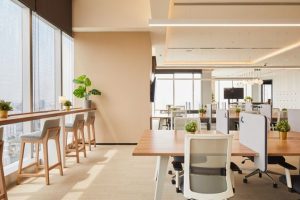
Ergonomic design extends beyond furniture and includes visual and audio elements. Traditional office lighting can cause strain on the eyes and create glare on computer screens. Ensure lighting is not too harsh but still allows for efficient work.
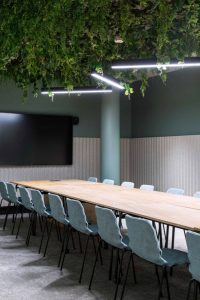
-
Minimalist approach
A cluttered space can lead to a cluttered mind, so it’s essential to keep furniture to a minimum. Create a clean and inspiring environment to start your workday with focus. Avoid stacking files and supplies on your desk and instead implement organized storage solutions. Choose sleek furniture instead of heavy and bulky pieces to maintain a neat appearance.
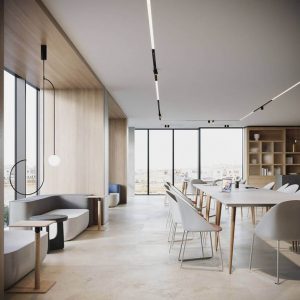
-
Color scheme
Choose colors wisely when decorating your office. Some colors can lift your mood and increase productivity, while others can make you feel low and demotivated. Grey, beige, and white can create a dull and gloomy atmosphere, while greens and blues promote focus and efficiency.
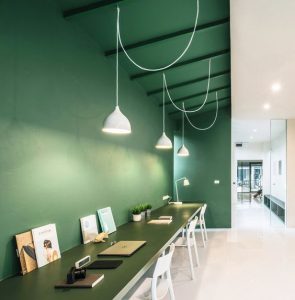
Yellow is a bright color that boosts confidence. Although a whole room of yellow may be overwhelming, a well-placed accent wall in the right setting can inspire passion and enhance your mood. Consider mimicking your brand’s color scheme, but opt for lighter shades for paint colors.
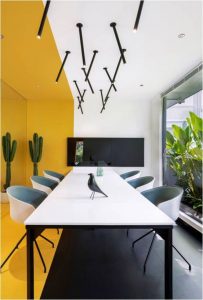
-
Illuminate your space
Poor lighting can make you feel tired and gloomy. Ensure ample lighting in your work area, including placing desks near windows to maximize natural light. Use sheer curtains instead of heavy blinds to allow natural light to enter the space.
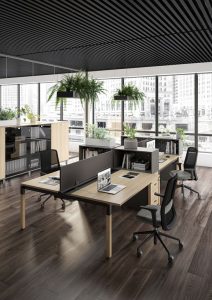
Traditional fluorescent office lights can be draining and even cause headaches. Consider using incandescent bulbs, white LED lights, and lamps to brighten your office.
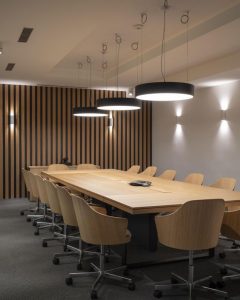
-
Bring in nature
Incorporating plants into your office can bring life and freshness to the space.
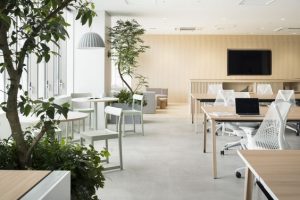
For larger offices with access to natural light, opt for statement plants. If you work in a cubicle, utilize wall space to hang plants. If you have limited space on your desk, consider small succulents and flowers to decorate your workspace.

-
Expert assistance
Decorating your office on your own can be challenging, so don’t hesitate to seek professional advice. A skilled interior designer can assist with planning an ergonomic space that fits your needs.
Take advantage of CBS International Commercial Design Consultation for a personalized design plan for your office. CBS International offers seamless solutions for your office interiors.
Having a workspace that is comfortable and inspiring is important for a successful workday. Use these tips when decorating your office to create a space that feels like home.
We spend a large portion of our day at work and it’s crucial that our surroundings inspire us to be productive and content. An uninviting workspace can decrease your motivation and productivity.That’s why CBS International is here to offer 6 simple tips to enhance your office space to increase productivity.
-
-
Advice
Dilemma: New vs Old Construction
When purchasing an apartment, people tend to consider its location, structure, floor position, view from the apartment, proximity to educational and health institutions, and whether there is parking and building maintenance.
When all these apartment characteristics fulfill expectations and personal financials do not represent an obstacle, there is still an eternal dilemma: whether to purchase a property within a newly built building, or old construction?
It is not easy to solve such dilemma, as both new and old construction have its advantages, therefore it is recommended to consult with real estate agencies.
FEATURES
New Construction

Modern beautiful new buildings. New apartments have many advantages, and the most important advantage is exactly that – it is a new apartment in a new building, with all new installations and built-in materials, and more often investors give a guarantee to clients for the work and equipment.
Newly built apartments don’t need renovation, and thanks to building regulations and the materials used, today’s residential buildings are more energy efficient, which results in lower maintenance costs and monthly overhead costs.
Besides this, apartments are adapted to today’s lifestyle. Modern interior design implies open space, less hallways, while a kitchen, dining and living rooms are basically one whole, thus the space is used with more functionality.
New construction in urban areas today has solved the issue of parking, mostly in the form of an underground garage, meanwhile larger residential complexes contain a variety of amenities available for residents.
Safety which newly built buildings provide represents one of the top priorities for a majority of investors. New buildings have modern methods of monitoring the building through video intercoms, card access to the entrance and garage, video surveillance. Professional security is increasingly present in the building 24/7, which increases the safety and sense of security for you and your household.
Concrete is predominantly used in new construction nowadays, thus it is believed that this “cold” material cannot replace the former brick buildings. However, new buildings are built according to the latest standards and have extremely high-quality thermal, hydro and sound insulation.
For the construction of modern, new residential buildings, better quality materials are used, and at the same time, new technology and a new way of construction of living space are used. Mainly, during the construction of new buildings, the needs of a modern lifestyle are also met.
Old Construction

Facade of a traditional apartment building The main advantage of old construction is the price, which is usually lower compared to new construction. The period in which the building is being built and the interior design of the apartment will make the property more affordable, while the location and additional renovation work could make the price higher.
The condition of the apartment also affects the price. Many apartments in older buildings are being renovated to make them more attractive to the market. If you are interested in such an apartment, it is recommended that you inform yourself in detail about works and adaptations.
However, it is important not to overlook that additional adaptations to the old apartment require larger investments. In addition to money, it also takes time to find quality contractors who will carry out the renovation within the stipulated time.
Another advantage is that the apartment is ready, available and ready for immediate occupancy, there are no worries about completing the construction of the building, and in most cases it has valid ownership documentation.
Older apartments have a traditional room layout where each room is separated from the other by walls. There may also be some kind of storage room, a larger hallway, often the ceilings are higher, so the apartment may seem larger compared to an apartment of the same square footage in a new building. In addition, older buildings usually have basements, which is not often the case with newly constructed buildings.
Many properties built in the previous period were built according to the plan, which means that the buildings are far enough from traffic roads, there are parking spaces for tenants, parks, green areas. Older properties are built from high quality durable and natural materials and often have high arches and thick walls.
Previously, construction workers used materials such as steel, wood, brick and concrete, which were considered to be their main advantage. However, due to the date of construction, it is recommended to check what materials were used in the construction, as well as the condition of the installations and carpentry in the apartment.
Adaptation according to wishes and capabilities!
When buying real estate, people are trying to adjust their wants and desires according to their budget. However, what happens when a certain structure of the apartment needs a little correction? Is that possible?
One of the most important advantages of buying a building in a building under construction is the ability to influence the layout of the rooms and participate in modification works and adapt the apartment to your needs.
If the layout of the interior is not exactly what the buyer expected, or wishes to rearrange the space in their home, these changes are possible and easier to implement while the residential complex is under construction.
In the case of apartments with an older construction date, it is generally possible to move, demolish or raise partition walls in order for the residents to adapt the layout of the rooms to their wishes and requirements. However, it is recommended to consult a professional who will review the project and provide proof in the form of a static calculation so that the wishes can be brought into reality, and only then proceed with the adaptation of the apartment. Every adjustment costs money, so the renovation of an old apartment implies certain investments.
How to come up with the final decision?
The final decision when solving the housing issue is mostly influenced by personal wishes and possibilities. While some buyers love the charm of older apartments, other clients are more attracted to the smell of a new home, open space and modern design. Considering the importance of the decision to enter the process of buying an apartment, it would still be good to consult real estate experts.Are you aware of the fact that an apartment purchase is one of the most important life decisions? Because of that, it is important to take into consideration all aspects before making the final decision. When purchasing an apartment, people tend to consider its location, structure, floor position, view from the apartment, proximity to educational and health institutions, and whether there is parking and building maintenance.
When all these apartment characteristics fulfill expectations and personal financials do not represent an obstacle, there is still an eternal dilemma: whether to purchase a property within a newly built building, or old construction?
It is not easy to solve such dilemma, as both new and old construction have its advantages, therefore it is recommended to consult with real estate agencies.
-
Workplace
What is a hybrid workplace model and how does it work?
What is a hybrid workplace model?
The hybrid workplace model combines remote workers with on-site workers, with some or all employees having the flexibility to choose where and when they work. In-office time may be allocated by days or by teams, or on an as-needed basis. Where and when work gets done will be determined by what makes the most sense to drive the highest levels of productivity and engagement.

Hybrid work model is somewhere in-between the standard in-person and remote work model. The hybrid model isn’t a fit for every workplace or every industry, it’s best suited to employees whose work is computer-based and doesn’t need to be performed on site. A recent report looked at remote work that can be done without loss of productivity. It determined that “about 20% to 25% of the workforces in advanced economies could work from home between three and five days a week. This represents four to five times more remote work than before the pandemic.”
The hybrid workplace model is not a temporary model, or a stop-gap, instead it’s the future of work and of agile, resilient workplaces.
Why the hybrid workplace is the developing norm
The move towards remote and hybrid work was happening long before the pandemic, but, as with so many things, COVID-19 accelerated the transition. Businesses had to quickly overcome a myriad of challenges, from providing the right tools to managing productivity and morale in a dispersed team environment. After a few months, however, it was clear that there was no going back – because employees preferred this new, more flexible way of working.
Now that some employees are reentering traditional office settings – at least some of the time – businesses can benefit from lessons learned from their remote work experiences. The goal is to design a hybrid work model that best suits their specific needs.
Modern HR technologies are easing the shift to hybrid work by making it possible to gather, manage, and analyze data from all teams, regardless of location. Technology can support employee onboarding, upskilling and reskilling, and, when used effectively, it also gives employees access to everything they need during their employee journey – from collaboration tools to cloud technologies.
The ideal “new normal” is an inclusive hybrid workplace where all employees – no matter where they’re working – are productive, engaged, and feel connected and included.
Benefits of a hybrid work environment
A hybrid workplace with a people-first approach to employee experience takes advantage of evolving HR technologies to become flexible, agile, and productive.
- Increased employee productivity: A number of factors contribute to boosts in productivity: increased autonomy to choose work hours and location; fewer interruptions at home than in the office; repurpose commuting time; and the opportunity to come into the office at times when in-person collaboration is best.
- Reduced overhead costs: Companies are looking at their real estate strategies and opportunities to reduce office space or move their offices to smaller cities – all of which can lower overhead. Hybrid employees tend to be more engaged, which leads to less turnover and also reduces costs.
- Better employee experience and work-life balance: Greater flexibility and autonomy increases job satisfaction and happiness, which improves performance at work as well as overall employee well-being. An integrated focus on work-life balance helps create a successful hybrid workplace.
- Improved safety and social distancing: With COVID-19 variants predicted to be an ongoing threat, the hybrid workplace model allows for office space to be designed to emphasize safety and sanitization. Mixing and matching who is in the office – and when – allows space for social distancing and increased cleaning, which also makes it easier if there is a need to perform contact tracing.

Challenges of managing hybrid teams
Every organization will face somewhat different challenges in making a hybrid work model successful. Below are some of the most common challenges facing hybrid team leaders today:
- Developing the right hybrid model: Because there are so few established hybrid workplace models to follow, each company must design and develop a model specific to their needs. This approach may also need to be iterative as different combinations and technologies are tried and tested to find the best fit for each company’s unique situation and culture.
- Increased security risks: As companies move towards hybrid models security will continue to be a risk and a concern. With employees working from home using their own networks, and potentially their own devices, HR and IT departments will need to focus on end-user education and security.
- Managing people effectively: In a hybrid workforce, managers must take care to ensure that both on-site and remote workers have the same opportunities and exposure, including evaluations that are based upon work product rather than work process. It is important to ensure that remote team members do not feel isolated or unseen – and likewise, that they are subject to the same expectations and accountability as their colleagues in the office.
- Employee isolation and disconnection: HR teams will have to focus on keeping employees feeling connected when their staff is working from anywhere at anytime. Developing “virtual water cooler” opportunities and other chances for employees to interact and connect in non-physical settings will be key to designing a healthy hybrid workplace. As will being able to use technology to take the pulse of the workforce and course correct as needed.
- Creating seamless connectivity: To avoiding disparities, silos, and knowledge loss, businesses need to develop barrier-free connectivity that allows hybrid teams to communicate quickly and efficiently. Maintaining a thriving company culture has to be an intentional goal in a hybrid workplace model.
-
Workplace
Workspace as inspiration for employees
When it comes to arrangement of office space, it is not a surprising fact that one of the priority tasks has always been to create an environment that will be functional and comfortable, as well as inspiring – one that encourages creativity and productivity of employees, team spirit and positive work atmosphere.
Office space used to be exclusively classic offices, physically completely separated from each other by walls, and in which a small number of employees worked

Classic (Closed space) Offices – Less noise or better acoustics than an open plan office as well as more privacy for the employees. With development of the first modern office buildings, this concept has changed and replaced by the open space concept known as the “open space” format, where all employees work and share the same space.
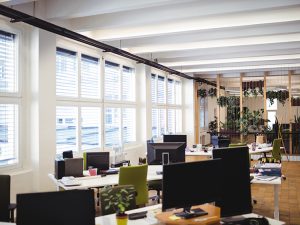
Open Space Offices – High levels of verbal communication between employees and employers. However, whether it is a classic office or open space, one thing is common – to find the perfect balance in arranging the space that will primarily contribute to the sense of belonging and well-being of employees because today, more than ever, employees are in the focus.
The transformation of office space, due to various influences, has led to a healthier, more spacious and open concept where through interior solutions special attention is paid to interaction between employees and the social aspect which, as time has shown, is irreplaceable in the work and life of each individual.
A good part of today’s employees belongs to the so-called Generation Z, which does not recognize the traditional type of offices or seating, has different habits and expectations of space, and therefore new trends are increasingly focusing on the comfort of individuals.
For some companies it’s a new trend, yet most of the companies prefer business space made up of combination of formal and less formal units, enriched with details that improve the space, giving it positive energy and defining a creative environment as a stimulus for inspiration.
Once it was hard to imagine, yet today it is very likely that you will not have your one desk in the office, designated exclusively for you, but there will be informal spaces and meeting rooms that instead of classic conference tables and chairs have comfortable armchairs and sofas, while special cabins for private and business conversations have been in use for a while. Relaxation zones are carefully designed to meet the needs of employees, and materials and specially selected colour palettes will enrich each space and give it a final and unique stamp
-
Shopping
Transformation of the shopping trends and habits
People are shopping online more than ever before. This trend has been highly influenced by the pandemic due to many restrictions it imposed, making it more convenient for individuals to simply shop online, instead of physically visiting stores. At one point these restrictions also implied closing of retail stores, thus some people were forced to change their shopping habits which resulted in a boost in growth of online shopping trend.
The trend involves purchasing products and services via the internet using credit or debit cards, with the purchased goods being delivered to your home. By shopping online, customers benefit from having accessibility to a global marketplace, meaning they can shop from anywhere in the world. This convenience automatically means that customers can choose from any brand or store, being exposed to a wider selection and more options. As shopping online can be done at any time during the day, from electronic devices such as smartphones, laptops and computers, it is a time-saving process with more and more customers choosing to rather use this approach, than to take the time and effort to visit the stores.
While all these benefits influenced the trend of online shopping to grow, there are some disadvantages to it as well. There are customers who enjoy the whole experience of shopping, preferring to do it in person, having the ability to feel and try on the products before making the decision whether to purchase. Therefore, the necessity for a traditional brick-and-mortar store for the highest conversion rates, has not decreased, moreover it is still very present.

Though shopping online is time saving, the shipping time could take up to a few days or even weeks, which makes it less appealing to customers. This obstacle has led companies around the world, to establish the “Same-day delivery” model. “Same-day delivery” service provides quick delivery, which is a significant convenience for customers, who have then started creating a demand for most businesses to offer the same. This service has the potential to fundamentally change the way we shop. In an effort to keep up with clients’ demands, businesses have been working with their logistics partners to find innovative solutions to deliver packages as soon as possible. Most retailers have already added an e-commerce channel to their traditional bricks-and-mortar sales approach. The combination with same-day delivery could help retain some of the customers that found online shopping less appealing due to prolonged shipping.
This model has not yet been thoroughly established everywhere, more specific in less developed countries, such as Macedonia. While the online shopping trend in Macedonia is on the rise, the improvements in the logistics and supply chain segments require further development in order to keep the trend growing.
-
Consulting
Why choose consulting companies when buying or selling real estate?
We are convinced that it is almost always the right solution to contact a real estate consultancy and leave the work to experienced industry experts. The reason is simple – this way, all the expectations and requests of the clients will be met in a professional way, thus the clients will get the support they deserve. Real estate experts will make this process more reliable and secure.
Given that there are usually several real estate agencies on the market, a new dilemma arises – how to choose the right one? Recommendations by close people and acquaintances have a significant role in resolving this dilemma and making a decision. Those who are satisfied with the outcome after their experience with a real estate agency and with work done by their consultants, have the opportunity to recommend that agency to others.
If this is not an option, the next step would be to search for real estate agencies in a particular area. In this case, the final choice is usually influenced by several factors: references and reputation of the researched companies, the number of licensed brokers within a company, as well as the time period of a company’s presence in the local market.
The real estate market represents a special segment of business, which is greatly influenced by the macro and micro-economic situation. Choosing a real estate agency with many years of experience in the market is in that case a better and, above all, a safer choice. Over the years, most of them have had the opportunity to gain useful experience and knowledge of global impacts on the local market.
After the research is completed and an agreement is reached with the selected agency, experienced professionals come into action, who will then provide the client with professional advice and services tailored to the needs of clients in all segments of the real estate market.
9 benefits of choosing to work with real estate agencies:
- Negotiation skills: professionals dealing with real estate properties in the local market, have the skills and experience in negotiating. Good negotiators will make it easier for you to get the best conditions and the best price for the selected property.
- Market knowledge: local real estate agencies focus heavily on the local market, which results in agents having useful, concrete information regarding realized transactions and prices, as well as market updates from the region. Therefore, they can provide you with the best advice at all times
- The right price: a professional agent will always try their best to negotiate the optimal prices for the client. Possessing additional industry knowledge such as knowledge about possible hidden pitfalls, and by making a comparison to other options on the market, a licensed broker can provide the client with the right price when closing a deal.
- Time-saving: hiring a real estate company will save you one of the most valuable personal assets these days – your time. Professionals who deal with this business on a daily basis, are a guarantee for your saved time.
- Advisory services: you will receive expert advice in all steps of the buying / selling / renting or leasing process.
- Documents: real estate agencies work daily with contracts and other important documents. Knowledge of the terminology and legal requirements will provide you with correct and secure documents without potential risks.
- The right client approach: consultants will communicate in an efficient, transparent and professional way with the other party.
- Sales experts: experts with many years of experience will be at your service on a daily basis, providing assistance in the sale process of multi-purpose real estate properties.
- Marketing: certain real estate companies also offer marketing services. An effective marketing strategy and campaign has the potential to promote properties and make them stand out which could result in a higher customer reach. This could speed up and result in more successful sales, or even create a better property commercialization.



